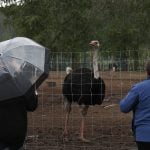Tag Archives british columbia

B.C. ostriches culled, CFIA confirms
.

B.C. ostriches culled, CFIA confirms

B.C. ostriches now to be culled after ruling: CFIA
Farm been at the centre of protests since CFIA first ordered the cull of over 300 birds

B.C. ostriches now to be culled after ruling: CFIA
Farm has been at the centre of protests since CFIA first ordered the cull of over 300 birds

B.C. ostrich flock cull paused amid U.S. push to save them

B.C. farmers to receive increased AgriStability supports
Government sites extreme weather, trade concerns for increased funding

Popham returns as B.C. ag minister
Former minister shuffled back to ag file after election

B.C.’s ag minister downed in fraught election
Governing party to be confirmed next week as votes recounted

Local food system would reap big economic benefits researcher says
B.C. researchers found that the Okanagan could produce two thirds of its own food while maintaining exports

AgriRecovery feed, freight, breeding herd aid set for Alberta, Saskatchewan, B.C.
Feds, provinces announce combined $365 million in aid programs


